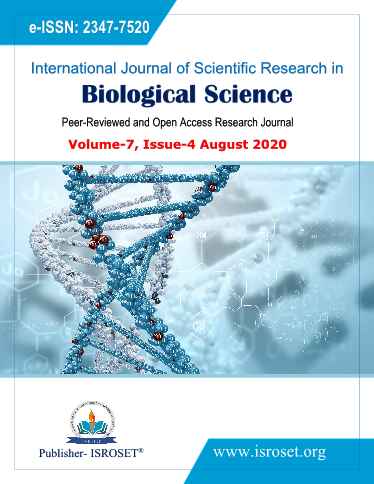Antifungal Properties of Biosurfactant Produced by Bacterial Strains SR17 and JS29 Against Phytopathogens of Rubber
Keywords:
Percentage Inhibition, Cell free supernatant, Surface tension and optical density, Phytopathogenic fungal cultureAbstract
Biosurfactants are microbial metabolites synthesized by certain microorganisms, yeast, and fungi. They possess characteristic features showing physiological properties especially antifungal and antibacterial behaviour. Among all derivatives of glycolipid particularly the species Pseudomonas that contains rhamnose biosurfactants proves to have the highest potential in inhibiting the flourishing range of phytopathogens. The practical examples of spraying of pesticides and fertilizers in the agricultural fields result in a hazardous impact in plant growth hence the application of biosurfactants have a promising future in different aspects of sustainable agriculture because of being biodegradable and cost effective. The paper focused on the inhibition by biosurfactants obtained from Pseudomonas aeruginosa SR17, Pseudomonas aeruginosa JS29, Bacillus altitudinis MS16 and V1 strain (not yet identified) against the rapid growth of phytopathogenic fungal cultures. In the initial stage, the inhibitory impact of Cell Free Supernatant (CFS) of each bacterial strains were homogenized with Potato Dextrose Agar (PDA) for analyzing upon phytopathogens. Later, the crude biosurfactant is extracted from centrifuged CFS at temperature 40°C under reduced pressure. Authors narrated that a 500mg/l concentration of crude is incorporated with PDA and analyzed for the inhibition. Paper concludes two noble strains SR17 and JS29, which demonstrate an average inhibition of 57% and 63% respectively. Biosurfactants of these two peculiar strains can be used effectively in the prevention of disease.
References
Muthusamy K, Gopalakrishnan S, Ravi TK, Sivachidambaram P, “Biosurfactants: properties, commercial production and application,” Current science, Vol.25, pp.736-47, 2008.
Van Hamme JD, Singh A, Ward OP, “Physiological aspects: Part 1 in a series of papers devoted to surfactants in microbiology and biotechnology,” Biotechnology Advances, Vol.24, No.6, pp.604-20, 2006.
Sarachat T, Pornsunthorntawee O, Chavadej S, Rujiravanit R, “Purification and concentration of a rhamnolipid biosurfactant produced by Pseudomonas aeruginosa SP4 using foam fractionation,” Bioresource technology, Vol.101, No.1, pp.324-30, 2010.
Anuradha S. Pendse, K. Aruna, "Physicochemical and analytical characterization of biosurfactant produced by Serratia rubidaea KAP", International Journal of Scientific Research in Biological Sciences, Vol.7, Issue.2, pp.25-40, 2020.
Deleu M, Paquot M, “From renewable vegetables resources to microorganisms: new trends in surfactants,” Comptes Rendus Chimie, Vol.7, No.6, pp.641-6, 2004.
Gautam KK, Tyagi VK, “Microbial surfactants: a review,” Journal of Oleo Science, Vol.55, No.4, pp.155-66, 2006.
Nitschke M, Costa SG, “Biosurfactants in food industry,” Trends in Food Science & Technology, Vol.18, No.5, pp.252-9, 2007.
Finnerty WR, “Biosurfactants in environmental biotechnology,” Current Opinion in Biotechnology, Vol.5, No.3, pp.291-5, 1994.
Adamczak M, odzimierz Bednarski W, “Influence of medium composition and aeration on the synthesis of biosurfactants produced by Candida antarctica,” Biotechnology Letters, Vol.22, No.4, pp.313-6,2000.
Kim HS, Yoon BD, Choung DH, Oh HM, Katsuragi T, Tani Y, “Characterization of a biosurfactant, mannosylerythritol lipid produced from Candida sp. SY16,” Applied microbiology and biotechnology, Vol.52, No.5, pp.713-21, 1999.
Mulligan CN, “Environmental applications for biosurfactants,” Environmental pollution, Vol.133, No.2, pp.183-98, 2005.
Downloads
Published
How to Cite
Issue
Section
License

This work is licensed under a Creative Commons Attribution 4.0 International License.
Authors contributing to this journal agree to publish their articles under the Creative Commons Attribution 4.0 International License, allowing third parties to share their work (copy, distribute, transmit) and to adapt it, under the condition that the authors are given credit and that in the event of reuse or distribution, the terms of this license are made clear.







